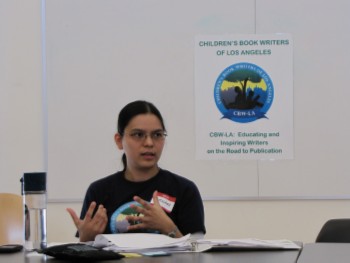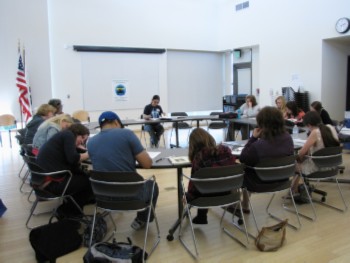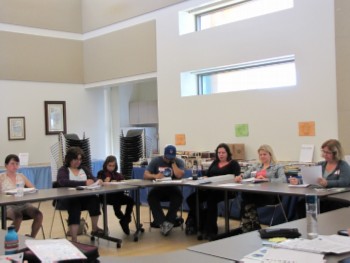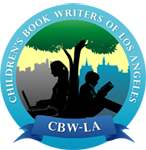Practice makes perfect. We know this to be true about every skill. The only way we can develop our writing skills is to keep on practicing. I’m not just talking about writing one novel after another, or writing picture book after picture book. I’m talking about honing our craft by focusing on the act of writing itself.
Often, the only kind of writing we do is related to the book, short story, or article we’re working on. Sometimes we need a break from our work. We need to have moments when we write just for fun, or for the purpose of learning how to write itself. This is when creative writing exercises come in handy.
Last Saturday’s meetup was dedicated to learning various writing exercises designed to help writers find your authorial voice and style, and hone their art of description.
WARM-UP: FREEWRITING
Freewriting is a great way to spark that new story idea or to warm up your writing muscles before diving into their manuscript.
I began the session by having everyone do some Freewriting.
I asked them to bring out the questions they had picked out from the box as they signed in earlier. I set the timer for 5 minutes. Using the question as a general guide for what they would write about, my group members wrote continuously for 5 minutes without stopping to edit or think, and without worrying about grammar, punctuation or sentence structure.

Facilitating the creative writing session
A. SOUND, STYLE, TONE & VOICE
In the first part of our session, we discussed the difference between Sound, Style, Tone & Voice. Most of the materials were taken from Noah Lukeman’s First Five Pages, as well as various other books and articles found online.
According to Noah Lukeman:
SOUND has to do mainly with the basic construction of the sentence –its flow, its rhythm, and is more of a technical issue.
Some sound problems we may find in our manuscript include poor sentence construction; echoes as found in the repetition of character’s names, pronouns or specific words; alliteration in prose, and resonanceundefinedthe way the sentence resounds within the context of a paragraph, line break, or chapter.
STYLE also has to do with sentence construction but has more to do with the intention behind the construction, and thus is as much an artistic issue as it is a grammatical one.
Ernest Hemingway wrote in simple, direct sentences and used few adjectives. Stephen King uses a lot of foreshadowing, and descriptive language in his books.
TONE is the voice behind the work, the driving intention behind the sound and style.
Sound/sentence construction can be technically wrong, but tone can never beundefinedit is always subjective, a matter of personal taste.
Sound, style and tone work jointly to affect the overall melody of a piece; but tone or voice sits on the opposite end of the spectrum from sound, with style falling somewhere in between.
Some authors use Voice and Tone interchangeably, while others believe Voice actually means the Writer’s Style. For our group however, we’ve defined Voice as a combination of both Tone & Style.
To illustrate how each author’s voice is distinct and unique, I gave them Worksheet 1 – which contained paragraphs taken from some popular books. I told them to see if they could recognize what books the paragraphs were lifted from.
Worksheet 2 also contained paragraphs lifted from some books. We went through several to see if we could identify the Tone used in each paragraph.

CBW-LA members working on the exercises
EXERCISES: FINDING YOUR VOICE
Here are some of the exercises we did after our discussion on Sound, Style, Tone and Voice:
1. Paraphrasing
Pick a paragraph from Worksheet 1 (or your favorite novel) and rewrite it with the same meaning, but in your own words. Try to make it as distinctly your own as you can.
2. Character Chat
Think of your protagonist, the lead in the story you’re currently writing, or the story you want to work on. Imagine him/her in a setting, staring at an object that’s in high contrast to her usual world.
For example, if your lead is a preschool teacher, put her in a prison yard. Or if your lead is a brain surgeon, have him describe watching a Native American dance. Or if your lead is a billionaire, have him describe the flavor of SPAM meat.
Try several of these chats, you’ll notice that one kind of perspective on life feels more right than others. Why is that?
3. Many Moods
Again, pick a paragraph from any of the two worksheets (or any book) you currently have. Write this paragraph in three ways.
- a. Write as if everything about the story infuriated you
- b. Write as if the story were breaking your heart
- c. Write as if the story scared the hell out of you.
Which one seems more natural to you?
For that particular story, that is your writing voice.
You can do this same exercise on your own. Take a single page of any novel and rewrite it in these three ways. Do the same with any one page of a novel and rewrite it twice, once as formally as you can and one informally. Look at these pages. Which one seems most natural?

CBW-LA members doing some creative writing
B. THE ART OF DESCRIPTION
The power of description is such that it can transform the two dimensional page into a 3D word. Often, however, description is something that find hard to write because it incorporates so many different elements –not just the setting, but also descriptions of the characters’ clothes and appearance, the objects they use, the weather, what they’re feeling and so on.
Some writers love action and dialogue and tend to forget about description. Their characters end up wandering through vague buildings and their readers don’t get a sense of time or place from their story. Some writers, on the other hand, include too much description. They expound on their setting so much, that it hinders the flow of their narrative. Their readers might read through a whole page describing a character’s room, and at the end of it, still wonder what the character is doing there and when the action will actually start.
I shared with everyone Anne Marble’s article on the art of description, and the eight tips she lists down to bring a setting to life.
Anne Marble’s 8 Tips to Good Description (Paraphrased, short version)
1. Avoid huge lumps of description.
- Long description describing the setting used to be popular in the past, but today’s reader won’t put up with that sort of thing anymore.
- This is especially true if you’re writing for kids and teens.
2. Make description an active part of the story.
- Find a way to blend your description into the story instead of writing lumps of narrative description.
- Use description in combination with action.
- Ex. “Zara grabbed her mug and gulped it down, shivering when a few drops of ale trickled under her leather top” vs. “The ale was cold. She wore a leather top.”
3. Describe what your characters would notice
- If your hero has been in that office building dozens of times, she will only give it a passing glance, so you shouldn’t spend time describing it, unless something within it has changed that’s important to the story.
4. Use strong, active, concrete writing words when writing description.
- Avoid adjectives.
- Use strong nouns and strong verbs
5. Use all the senses.
- Most writers tend to concentrate on sight and sound, but you can bring a scene to life by including the other sensesundefinedsmell, taste, touch.
- Also, just because sight and sound are commonly used, doesn’t mean you have to make them common. Find a new way to describe things your characters see and hear. Don’t fall back on clichés to describe your character’s eyes or featuresundefinedinvent new ways of describing.
6. Fit description to the type of the story
- If you’re writing an action oriented piece, description will get in the way of pace
- If you’re writing a slower paced story, description will be an important part of it.
- Spooky paranormal tale might use description to build up the sense of the uneaseundefinedlinger on descriptions of dark hallways in the old mansion and hint that there are ghosts there.
7. Avoid excessive name dropping.
- It’s okay to use brand names in stories but get the trademark correct, don’t use them in a generic or incorrect sense and don’t portray the product in a disparaging light.
- Brand names can be a good way to provide the reader with a quick, concrete description but don’t use them too much and too often.
8. Don’t let description hang you up during a first draft.
- If you’re not comfortable writing description, don’t let it get in the way when you’re writing the first draft. Remember you can always go back and add them in later.
DESCRIPTION EXERCISES
1. WORDPOOL
Susan Goldsmith Woodridge, in her book Poem Crazy, suggests that we collect words whenever we can. Words we see around us, or words that just pop into our heads. Look into dictionaries, field guides, write down street names, product labels, names of people, etc.
Wordpools are an excellent source of inspiration and a great way to stretch our imagination.
Anne Marble suggests that we use strong active concrete words when we write description.
In this first activity, I asked my members to create 2 wordpools. A Noun Wordpool and a Verb Wordpool. In their given Wordpool worksheet, they wrote down specific nouns (not house, but cottage or bungalow) and strong verbs (not walk, but stagger or stride).
2. WORD ALCHEMY
Alchemy is defined as a medieval chemical science and speculative philosophy aiming to achieve the transmutation of the base metals into gold, the discovery of a universal cure for disease, and the discovery of a means of indefinitely prolonging life. But it is also defined as a power or process of transforming something common into something special.
Susan Goldsmith Woodridge, in her book Poem Crazy, suggests giving colors to abstractions or concepts.
- For example: Blue love, Chartreuse agreements, Silver deliberation, Magenta pride
For the second exercise, I gave out two colored pieces of paper. On the yellow paper I asked them to write a color (such as magenta or periwinkle), and on the blue piece of paper, I asked them to write an abstract concept (such as deliberation, love,pride,etc).
Once they had done that, I had them pass the yellow card to the left and the blue card to the right. Combining the words on the two cards, they came up with a new color-concept word (such as Maroon Love or Silver Fear). I had them pass their cards several more times so they could come up with new color-concept words.
3. SENSE STOREHOUSE
Anne Marble encourages us to use all the senses when describing things in our stories. One way we can do this is by building a Storehouse of sense related words.
The 3rd exercise was all about thinking up descriptive words that pertain to each of the senses.
For example:
- sight = blurry, twinkling,
- sound = honking,
- smell = lemon, pungent
- taste= vinegary, sweet
- touch= furry, curdled, silky
Whenever you encounter a new sense related word as you read your books, newspapers, listen to the radio or watch TV, add them to the list.
4. IN THE BELLY OF THE BEAST
Our final exercise was from Brian Kiteley’s book The 3 A.M. Epiphany, (which is a great book to have if you want to get your hands on hundreds of wonder creative writing exercise).
But I modified the exercise to include all the stuff we just learned about sound, style, tone, voice and description.
IN THE BELLY OF THE BEAST (From Brian Kiteley’s 3 A.M. Epiphany)
Describe an unusual interior space, one with lots of interesting appurtenances and gadgets sticking out: a submarine, a small plane, a subway tunnel away from the platform, a boiler room in the subbasement of a high rise building, the warehouse-sized vault of a Federal Reserve Bank.
Do not yield to the easy use of this scene. The boiler room, for instance, we all expect would conceal an axe murderer. Put two innocent children in it instead, romping and playing among the glow and roar of the fire and steam events as if this were a sunny playground (their father is the superintendent of the building and he prefers to keep the kids where he can see them).
RULES:
- Use words from your Noun Wordpool and Verb Wordpool
- Usedescriptive words you previously listed down in the Sense Storehouse exercise.
- Use at least one color-concept word (from the Word Alchemy exercise)
After this exercise, we all shared what we wrote down.
REFERENCES:
The First Five Pages by Noah Lukeman
Your First Novel by Ann Rittenberg & Laura Whitcomb
The Art & Craft of Storytelling by Nancy Lamb
The 3 A.M. Epiphany by Brian Kiteley
The Art of Description: 8 Tips to Bring Your Settings To Life by Anne Marble





